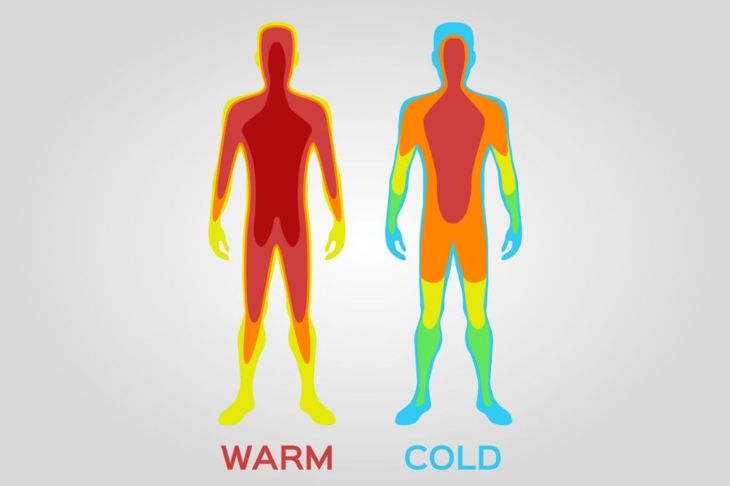The gender battle over A/C control has been raging for decades, and it will likely continue as long as men and women share spaces. For the most part, men feel cozy at temperatures that make women’s teeth chatter. In a futile counterplay, women reset temperatures to their comfort and the men’s consternation. Scientific research indicates these disagreements over the thermostat aren’t just stubbornness — they have a strong biological basis. It’s not all in our heads, although the brain plays a huge role in how hot or cold people feel. Various factors drive gender differences in body temperature.
Thermoregulation
The human body has an intricate mechanism for regulating temperature. It constantly works to maintain a core temperature between 98 °F and 100 °F when the environmental temperature is between 68 °F and 130 °F. When the skin temperature falls below 98.6 °F, the body responds in several ways to conserve heat and increase heat production. Blood vessels contract to reduce the flow of heat to the skin’s surface. Shivering boosts heat production in muscle tissue. The hypothalamus, a small area of the brain, directs the secretion of the hormones epinephrine, norepinephrine, and thyroxine to increase heat production.
Thermoception
Males and females have similar core body temperatures, but the female internal temperature may be a bit higher. However, skin temperatures have a greater influence on thermoception or thermoreception, our perception of temperature. For women, this is usually lower. A 2017 study published in Biology of Sex Differences found that women displayed greater sensitivity to cold and heat than male participants.
Why Office Temperatures Favor Men
Most offices set their thermostats based on a thermal comfort model from the 1960s. One of the model’s major variables is metabolic rate, based on an average male dressed in a typical mid-20th-century worker’s uniform or suit. A 2015 letter published in Nature Climate Change argues that the thermal comfort model does not consider the metabolic rate of women, which is up to 35% lower than that of men. Consequently, indoor climate standards do not reflect the thermal demand of the female population.
Metabolism
The human body’s metabolism dictates heat production, and men typically have a higher metabolic rate than women. Males tend to generate more heat inside their bodies to fuel their muscle mass, which is usually greater than females. Men’s higher resting metabolism necessitates more calorie burning and blood flow. The skin, clothes, and air just above the skin’s surface warm up as the heat dissipates, helping to keep the extremities warm.
Body Size Differences
Some scientists believe that body size plays a major role in thermoception. Men are normally larger than women in weight and height. Women have a greater surface area to volume ratio, so they lose heat at a faster rate. Women who are overweight may still feel colder than men because fat does not generate as much heat as muscle.
Cold Hands
Women often rub their hands together, trying to warm them. Generally, women’s hands and feet are about three degrees colder than men’s. This difference occurs because women’s bodies pull heat back to their organs to maintain normal core temperature. Estrogen thickens the blood slightly, which reduces blood flow to capillaries in the body’s extremities. Studies also suggest that many women feel colder when they ovulate, a time that coincides with elevated estrogen levels.
Menopause
Women experiencing the “change of life” might feel warmer due to hormonal changes. During the years leading up to and including menopause, the regular monthly cycle of estrogen production becomes erratic. This affects the hypothalamus, prompting spasms in the blood vessels that cause extreme temperature changes known as hot flashes.
Other Variables
Core and peripheral body temperatures can fluctuate due to many factors, so some researchers hesitate to pinpoint gender as a major issue. Age, certain foods, physical activity levels, smoking, and sleep impact our thermoception. Psychological issues such as depression or loneliness can also affect how hot or cold we feel, male or female. Furthermore, the manner by which our bodies lose heat — radiant, evaporative, or conductive/convective — depends on our overall condition and the immediate environment.
It All Evens Out…Maybe
Women may temporarily welcome lower room temperatures as their estrogen levels oscillate. After menopause, they tend to fall back to their pre-menopause room temperature sweet spot. As men age, they start losing muscle mass and stop generating as much heat. Thus, room temperatures that used to be comfortable for many men become too cold for them. Eventually, older men and women come closer to agreeing on the A/C setting.
When to See a Doctor
Constantly feeling cold, especially in room temperatures that used to be comfortable for you, maybe a sign of illness. Consult your primary healthcare provider if:
- You experience chills
- Your nails turn dark or blue
- Your skin becomes brittle
- You begin to sweat significantly more or less than you normally would.

 Home
Home Health
Health Diet & Nutrition
Diet & Nutrition Living Well
Living Well More
More




















